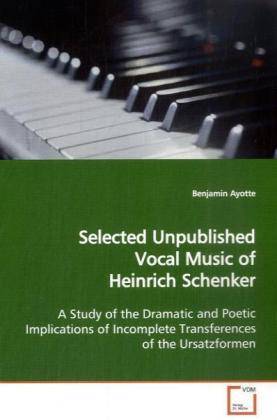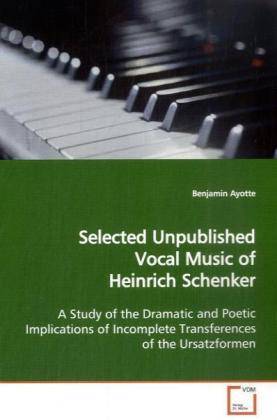
- Afhalen na 1 uur in een winkel met voorraad
- Gratis thuislevering in België vanaf € 30
- Ruim aanbod met 7 miljoen producten
- Afhalen na 1 uur in een winkel met voorraad
- Gratis thuislevering in België vanaf € 30
- Ruim aanbod met 7 miljoen producten
Zoeken
Selected Unpublished Vocal Music of Heinrich Schenker
A Study of the Dramatic and Poetic Implications of Incomplete Transferences of the Ursatzformen
Benjamin Ayotte
Paperback | Engels
€ 48,45
+ 96 punten
Omschrijving
Part I of this book will serve as an introduction to
Heinrich Schenker as a composer and to the
theoretical and philosophical bases of the
subsequent analysis by surveying the development of
the organic metaphor throughout his writings. It
consists of (1) a biographical sketch highlighting
experiences and relationships pertinent to his
development as a composer; (2) an overview of his
compositions; (3) an examination of contemporaneous
critical reaction based on archival research; and
(4) an account of the genesis of the concepts of
monotonality and the organic metaphor through his
theoretical work illustrated by examples from the
standard repertoire. Part II, the analytical
component, consists of (1) a presentation of the
main compositional techniques to be discussed,
namely incomplete transferences of the Ursatzformen
and hidden motivic repetition, as found in
Schenker s writings and illustrated by examples
drawn from both the standard repertoire and
Schenker s own works; and (2) demonstrations, via
analytical commentary and graphic analyses, that
several of Schenker s unpublished vocal works show
his dramatic and poetic use of auxiliary cadence
rogressions.
Heinrich Schenker as a composer and to the
theoretical and philosophical bases of the
subsequent analysis by surveying the development of
the organic metaphor throughout his writings. It
consists of (1) a biographical sketch highlighting
experiences and relationships pertinent to his
development as a composer; (2) an overview of his
compositions; (3) an examination of contemporaneous
critical reaction based on archival research; and
(4) an account of the genesis of the concepts of
monotonality and the organic metaphor through his
theoretical work illustrated by examples from the
standard repertoire. Part II, the analytical
component, consists of (1) a presentation of the
main compositional techniques to be discussed,
namely incomplete transferences of the Ursatzformen
and hidden motivic repetition, as found in
Schenker s writings and illustrated by examples
drawn from both the standard repertoire and
Schenker s own works; and (2) demonstrations, via
analytical commentary and graphic analyses, that
several of Schenker s unpublished vocal works show
his dramatic and poetic use of auxiliary cadence
rogressions.
Specificaties
Betrokkenen
- Auteur(s):
- Uitgeverij:
Inhoud
- Aantal bladzijden:
- 116
- Taal:
- Engels
Eigenschappen
- Productcode (EAN):
- 9783639108422
- Uitvoering:
- Paperback

Alleen bij Standaard Boekhandel
+ 96 punten op je klantenkaart van Standaard Boekhandel
Beoordelingen
We publiceren alleen reviews die voldoen aan de voorwaarden voor reviews. Bekijk onze voorwaarden voor reviews.











